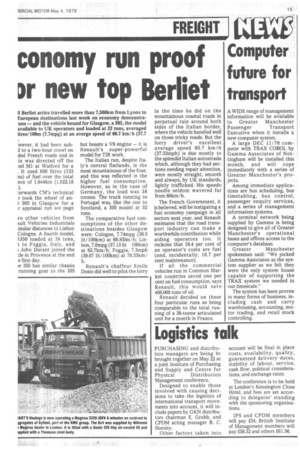conomy run proof Dr new top Berliet
Page 17

If you've noticed an error in this article please click here to report it so we can fix it.
R Berliet attics travelled more than 7,500km from Lyons to European destinations last week on economy demonstrauns — and the vehicle bound for Glasgow, a 305, the model available to UK operators and loaded at 32 tons, averaged itres/100m (7.7mpg) at an averge speed of 60.7 km/h (37.7 wever, it had been subcl to a two-hour crawl on ded French roads and in in was directed off the :ed M1 at Watford for a . It used 600 litres (132 as) of fuel over the total nce of 1,644km (1,022.18 terwards CM's technical r took the wheel of anr 305 in Glasgow for a r appraisal run see page vo other vehicles from suit Vehicles Industrials imilar distances to Lisbon Cologne. A fourth model, Z350 loaded at 38 tons, t to Foggia, Italy, and ; John Durant joined the cle in Provence at the end e first day.
ie 350 has similar chassis running gear to the 305 but boasts a V8 engine – it is Renault's super-powerful model for TIR work.
The Italian run, despite Italy's central flatlands, is the most mountainous of the four, and this was reflected in the higher fuel consumption. However, as in the case of Germany, the load was 38 tonnes. The truck running to Portugal was, like the one to Scotland, a 305 model at 32 tons.
The comparative fuel consumptions of the other destinations besides Glasgow were: Cologne, 7.74mpg (36.5 lit/100km) at 68.85Im/h; Lisbon, 7.6mpg (37.13 lit 100km) at 62.7km/h; Foggia, 7.3mph (39.07 lit/100km) at 70.33km/ h.
Renault's chaffeur Emile Dosio did well to pilot the lorry in the time he did on the mountainous coastal roads in perpetual rain around both sides of the Italian border, where the vehicle handled well on those tricky roads. But the lorry driver's excellent average speed 60.7 km/h (37.33mph) is due mostly to the splendid Italian autostrada which, although they had sections needing repair attention, were mostly straight, smooth and always, by UK standards, lightly trafficked. His speedo needle seldom wavered far from 80km/h.
The French Government, it is believed, will be instigating a fuel economy campaign in all sectors next year, and Renault estimates that the road transport industry can make a worthwhile contribution while aiding operators too. It reckons that 16.4 per cent of an operator's costs are fuel (and, incidentally, 16.7 per cent maintenance).
If all the commercial vehicles run in Common Market countries saved one per cent on fuel consumption, says Renault, this would save 400,000 tons of oil.
Renault decided on these four particular runs as being comparable to the total running of a 38-tonne articulated unit for a month in France.
























































































































